Explore an enchanting world of nature with our guide to amazing trees that start with ‘M’. From majestic Maples to mystical Magnolias, uncover their beauty, benefits and fascinating facts.
Trees are nature’s silent giants. They stand tall, proud and full of secrets. Today, we’re going to explore some amazing trees that all have one thing in common – their names trees start with the letter ‘M’. These trees aren’t just pretty to look at. They play big roles in our world, from giving us food and wood to helping our planet breathe.
Let’s start our journey through the world of ‘M’ trees!
Maple Trees
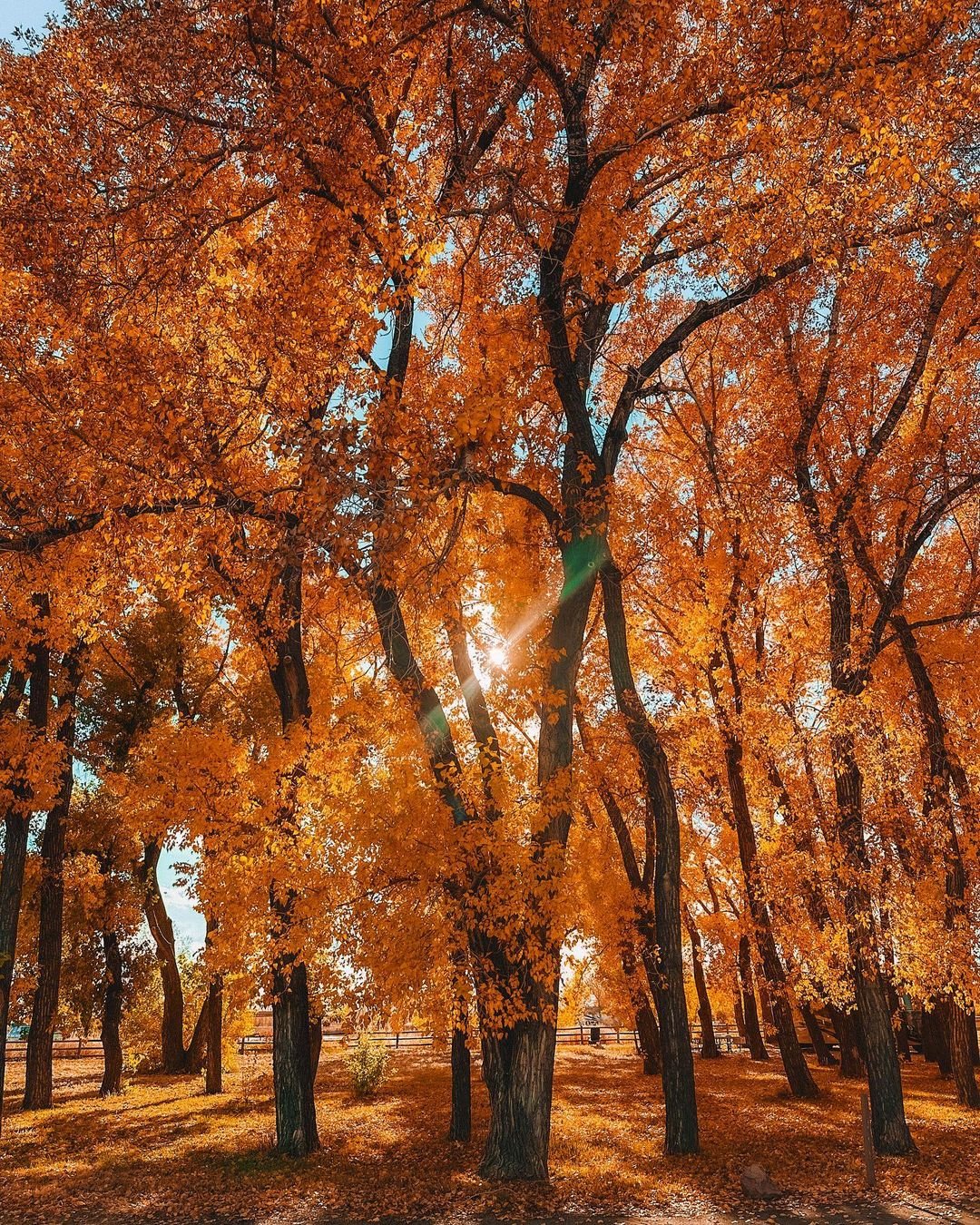
Here’s an easy and verified chart for Maple Trees (Acer spp.):
| Category | Details |
|---|---|
| Botanical Name | Acer spp. |
| Common Name | Maple Tree |
| Plant Name | Maple |
| Zone | Zones 3-9, depending on the species |
| Sun Exposure | Full sun to partial shade |
| Soil Type | Well-draining, fertile soil |
| Watering | Regular; moderate to high water needs |
| Growth Habit | Deciduous tree |
| Height/Spread | 20-100 feet tall, depending on species; spread varies |
| Special Features | Lobed leaves with vibrant fall colors (red, orange, yellow); some species produce sap for maple syrup; ornamental and shade trees; attractive bark and branching patterns; important for wildlife; various species suited to different climates and soils |
Maple trees are loved all over the world. They’re known for their beautiful leaves that turn bright colors in fall. But there’s more to maples than just good looks.
Did you know that maple trees give us maple syrup? It’s true! Maple syrup comes from the sap of sugar maple trees. People tap the trees to get the sap, then boil it down to make the sweet syrup we love on pancakes.
Maple wood is also very useful. It’s hard and strong, making it great for furniture, floors and even musical instruments. Many guitars and drums are made from maple wood because it sounds so good.
There are many types of maple trees. Some common ones are:
- Sugar Maple
- Red Maple
- Japanese Maple
- Silver Maple
Each type has its own special features. For example, Japanese Maples are often small with delicate, lacy leaves. They’re popular in gardens because they’re so pretty.
Maple trees are also good for the environment. They help clean the air and provide homes for birds and animals. In cities, they give shade and make streets look nicer.
Learn more about maple trees from the University of Maine’s Cooperative Extension.
Magnolia Trees
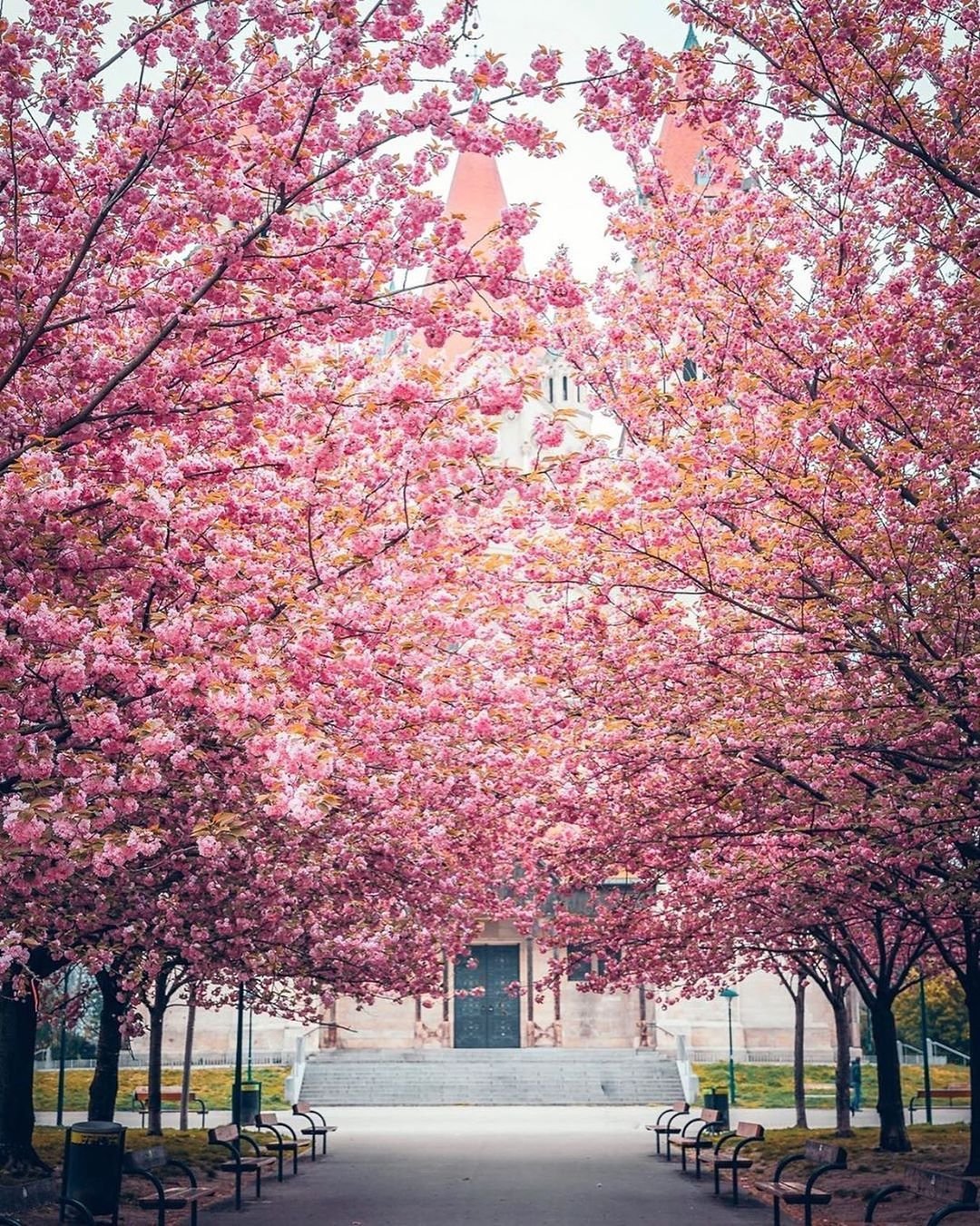
Here’s an easy and verified chart for Magnolia Trees (Magnolia spp.):
| Category | Details |
|---|---|
| Botanical Name | Magnolia spp. |
| Common Name | Magnolia Tree |
| Plant Name | Magnolia |
| Zone | Zones 4-9, depending on the species |
| Sun Exposure | Full sun to partial shade |
| Soil Type | Well-draining, slightly acidic to neutral soil |
| Watering | Regular; prefers moist soil but can tolerate some drought |
| Growth Habit | Deciduous or evergreen tree/shrub |
| Height/Spread | 10-80 feet tall, 10-40 feet wide, depending on species |
| Special Features | Large, fragrant flowers in white, pink, purple or yellow; glossy, green leaves; attractive bark; used as ornamental and shade trees; attracts pollinators such as bees and butterflies; some species have edible flowers and buds; known for their striking blooms in spring or summer |
Magnolia trees are known for their big, beautiful flowers. These flowers can be white, pink or even purple. They smell nice too!
Magnolias are very old trees. Scientists have found magnolia fossils that are millions of years old. This means magnolias were around when dinosaurs roamed the Earth!
There are over 200 types of magnolia trees. Some are big trees, while others are more like bushes. Some stay green all year, while others lose their leaves in winter.
Magnolias are popular in gardens because:
- They have pretty flowers
- Many types keep their leaves all year
- They can grow in different climates
In some places, magnolia flowers and leaves are used to make medicine. Some people use them to help with coughs or stress.
Magnolias are also important in art and culture. In the southern United States, the magnolia is a symbol of strength and beauty.
Want to learn more? Check out the Magnolia Society International.
Mahogany Trees
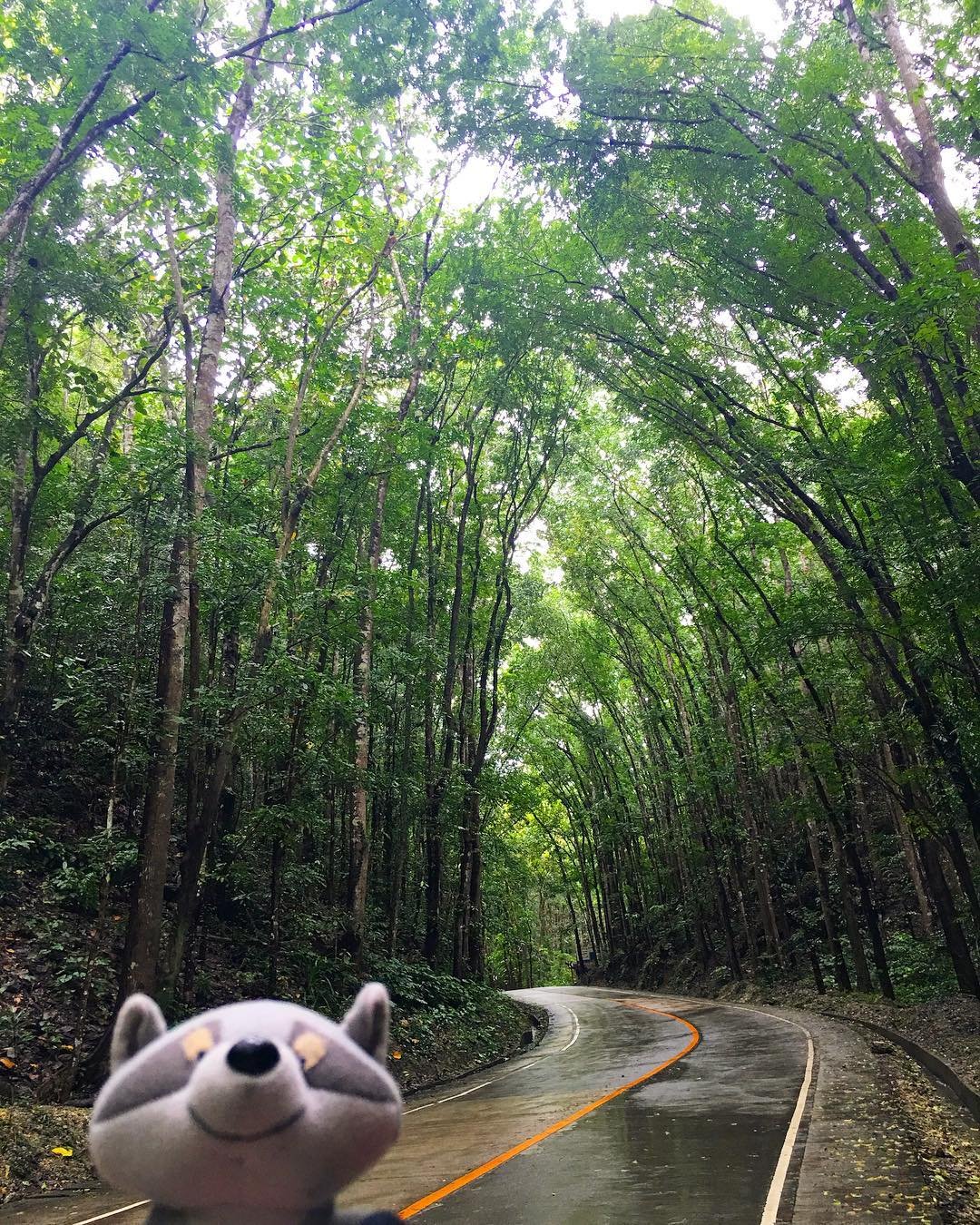
Here’s an easy and verified chart for Mahogany Trees (Swietenia spp.):
| Category | Details |
|---|---|
| Botanical Name | Swietenia spp. |
| Common Name | Mahogany Tree |
| Plant Name | Mahogany |
| Zone | Zones 10-11 |
| Sun Exposure | Full sun |
| Soil Type | Well-draining, sandy to loamy soil |
| Watering | Regular; drought-tolerant once established |
| Growth Habit | Evergreen tree |
| Height/Spread | 30-100 feet tall, 20-50 feet wide |
| Special Features | Valuable hardwood used in furniture and woodworking; glossy, pinnate leaves; small, fragrant flowers; produces woody capsules with winged seeds; tolerant of coastal conditions; important in reforestation and conservation efforts; native to tropical regions of the Americas |
Mahogany trees are famous for their beautiful wood. This wood is reddish-brown and has a nice grain pattern. It’s used to make fancy furniture, boats and musical instruments.
Mahogany trees grow in tropical places like Central and South America and parts of Africa. They can grow very tall – some reach over 150 feet high!
Sadly, many mahogany trees have been cut down over the years. This is because their wood is so valuable. Now, there are rules to protect these trees and make sure they don’t disappear.
Mahogany trees are important for the environment too. They:
- Provide homes for animals and birds
- Help stop soil from washing away
- Store carbon, which helps fight climate change
Some interesting facts about mahogany:
- The wood is resistant to rot and insects
- It gets darker and more beautiful as it ages
- Many antique furniture pieces are made from mahogany
Learn more about mahogany conservation from the World Wildlife Fund.
Mangrove Trees
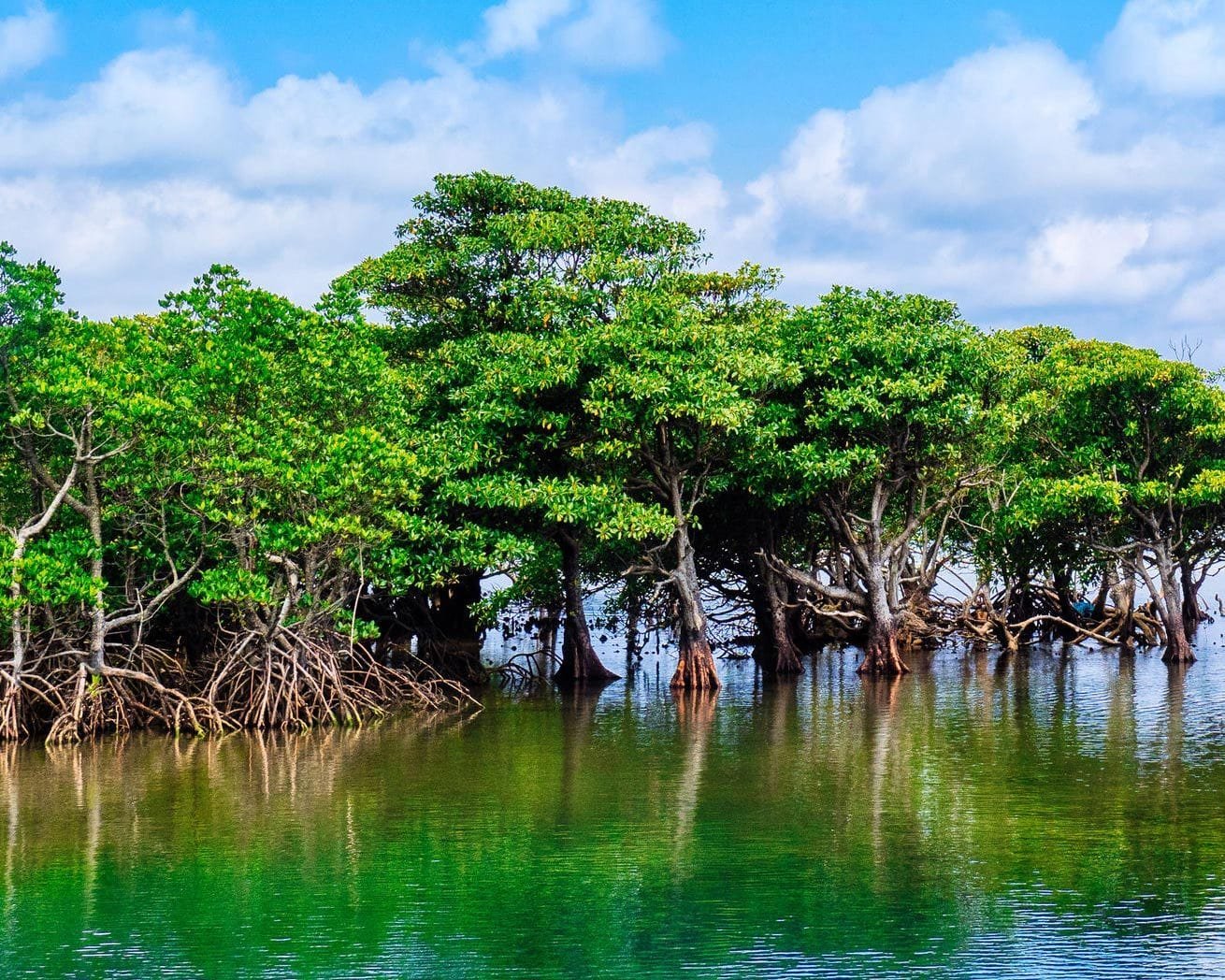
Here’s an easy and verified chart for Mangrove Trees (various species):
| Category | Details |
|---|---|
| Botanical Name | Rhizophora spp., Avicennia spp., Laguncularia spp., etc. |
| Common Name | Mangrove Tree |
| Plant Name | Mangrove |
| Zone | Zones 10-11 |
| Sun Exposure | Full sun |
| Soil Type | Coastal, saline, waterlogged soils |
| Watering | Thrives in brackish water; found in intertidal zones |
| Growth Habit | Evergreen tree/shrub |
| Height/Spread | 10-30 feet tall, 10-20 feet wide, varies by species |
| Special Features | Adapted to saline and brackish water; aerial and prop roots; important for coastal protection and erosion control; habitat for diverse marine and bird species; produces small, inconspicuous flowers and fruits; vital for carbon sequestration and water filtration; found in tropical and subtropical regions |
Mangrove trees are special because they can grow in salt water. They’re found on the coasts of tropical and subtropical places around the world.
Mangroves are superheroes of the tree world. They:
- Protect coastlines from storms and waves
- Provide homes for fish, birds and other animals
- Help clean water by filtering out pollutants
- Store lots of carbon, which helps fight climate change
These trees have some cool features to help them live in salty water:
- Special roots that stick up out of the water to get air
- Ways to get rid of extra salt through their leaves
- Seeds that can float in water for a long time to find new places to grow
Mangroves are very important, but they’re in danger. Many have been cut down to make room for buildings or fish farms. Now, people are working hard to protect and replant mangroves.
Discover more about mangroves from NOAA’s National Ocean Service.
Mimosa Trees
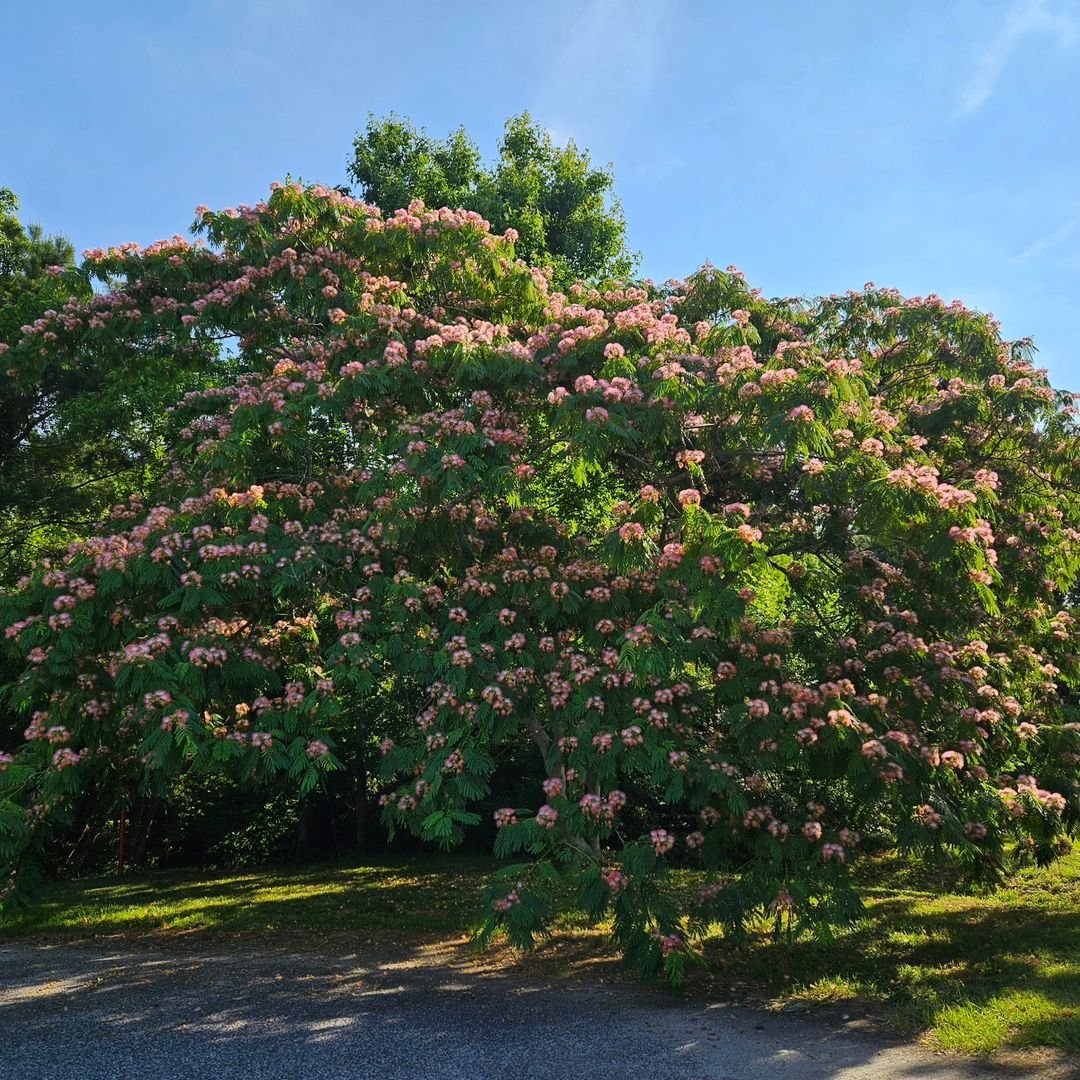
Here’s an easy and verified chart for Mimosa Trees (Albizia julibrissin):
| Category | Details |
|---|---|
| Botanical Name | Albizia julibrissin |
| Common Name | Mimosa Tree, Silk Tree |
| Plant Name | Mimosa |
| Zone | Zones 6-9 |
| Sun Exposure | Full sun to partial shade |
| Soil Type | Well-draining, loamy soil |
| Watering | Moderate; drought-tolerant once established |
| Growth Habit | Deciduous tree |
| Height/Spread | 20-40 feet tall, 20-50 feet wide |
| Special Features | Feathery, fern-like leaves; fragrant, pink, fluffy flowers in summer; attracts butterflies and hummingbirds; rapid growth; tolerant of urban conditions; can become invasive in some areas; used as ornamental tree for its attractive flowers and foliage |
Mimosa trees, also called silk trees, are known for their fluffy pink flowers and feathery leaves. These trees are native to Asia but now grow in many warm parts of the world.
Mimosa trees are interesting because:
- Their leaves close up at night or when touched
- They grow fast and can live in different types of soil
- Their flowers attract butterflies and hummingbirds
While mimosa trees are pretty, they can sometimes be a problem. In some places, they grow too well and crowd out other plants. This is why they’re considered invasive in parts of the United States.
Some people use parts of the mimosa tree for medicine. The bark and flowers are used in traditional Chinese medicine to help with various health issues.
Fun fact: The mimosa tree is not related to the mimosa drink! The drink is named after a different plant.
Learn about managing mimosa trees from the U.S. Forest Service.
Mango Trees

Here’s an easy and verified chart for Mango Trees (Mangifera indica):
| Category | Details |
|---|---|
| Botanical Name | Mangifera indica |
| Common Name | Mango Tree |
| Plant Name | Mango |
| Zone | Zones 10-11 |
| Sun Exposure | Full sun |
| Soil Type | Well-draining, sandy or loamy soil |
| Watering | Regular; deep watering during dry periods |
| Growth Habit | Evergreen tree |
| Height/Spread | 30-100 feet tall, 30-50 feet wide |
| Special Features | Large, leathery leaves; small, fragrant flowers; produces edible mango fruits; attracts pollinators such as bees; requires warm, tropical climates; fruits used in culinary applications worldwide; has cultural and economic significance in many tropical regions; can be grown in containers in cooler zones if protected from frost |
Who doesn’t love a sweet, juicy mango? Mango trees give us one of the world’s most popular fruits. These trees are native to South Asia but now grow in many warm parts of the world.
Mango trees are special because:
- They can live for hundreds of years
- Their fruit is nutritious and tasty
- They have cultural importance in many countries
Mangoes are more than just a yummy snack. They’re packed with vitamins and nutrients that are good for our health. They have lots of vitamin C, which helps keep our immune system strong.
Mango trees need warm weather and lots of sun to grow well. They don’t like frost or cold temperatures. In some places, people grow dwarf mango trees in pots so they can move them inside when it’s cold.
Parts of the mango tree, like the bark and leaves, are sometimes used in traditional medicine. However, it’s always best to check with a doctor before trying any new treatments.
Interesting mango facts:
- There are hundreds of different types of mangoes
- Mango trees can grow very tall – up to 100 feet or more
- The mango is related to cashews and pistachios
Want to grow your own mango tree? Check out tips from the University of Florida’s IFAS Extension.
Mulberry Trees
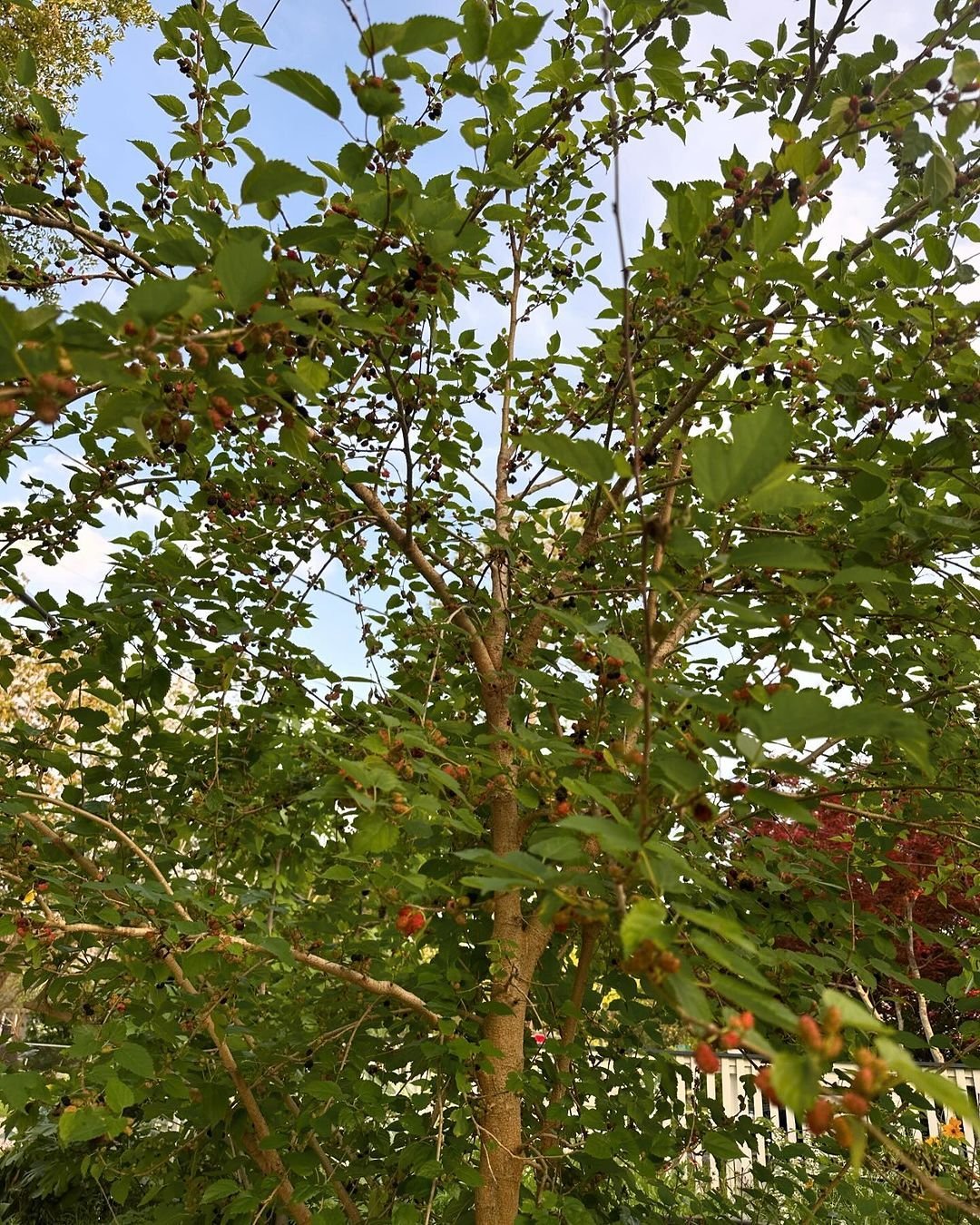
Here’s an easy and verified chart for Mulberry Trees (Morus spp.):
| Category | Details |
|---|---|
| Botanical Name | Morus spp. |
| Common Name | Mulberry Tree |
| Plant Name | Mulberry |
| Zone | Zones 4-9, depending on the species |
| Sun Exposure | Full sun |
| Soil Type | Well-draining, adaptable to various soil types |
| Watering | Regular; drought-tolerant once established |
| Growth Habit | Deciduous tree |
| Height/Spread | 30-60 feet tall, 20-40 feet wide |
| Special Features | Produces edible, sweet berries (black, red or white); attractive, lobed leaves; fast-growing; attracts birds and pollinators; can be used for shade; some species have invasive tendencies; berries used in jams, desserts and wines; some varieties suitable for silkworm cultivation |
Mulberry trees are known for their tasty fruit and their importance in silk production. There are several types of mulberry trees, including white, red and black mulberries.
Mulberries are special because:
- Their fruit is sweet and can be eaten fresh or made into jams and pies
- Their leaves are food for silkworms, which make silk
- They’re tough trees that can grow in many different places
Mulberry trees have been important to humans for thousands of years. In ancient China, people grew white mulberry trees to feed silkworms. The silk trade became a big part of the economy and culture.
Today, mulberry trees are still valued for their fruit and as ornamental trees in gardens. Some interesting facts about mulberries:
- The fruit isn’t really a berry – it’s made up of lots of tiny fruits stuck together
- Mulberry wood is yellow and gets darker when exposed to air
- Birds love mulberries, so these trees are great for attracting wildlife to your garden
However, mulberry trees can sometimes be messy. The fruit can stain sidewalks and cars if it falls on them. Some cities have even banned certain types of mulberry trees because of this.
Learn more about mulberry trees from the Arbor Day Foundation.
Myrtle Trees
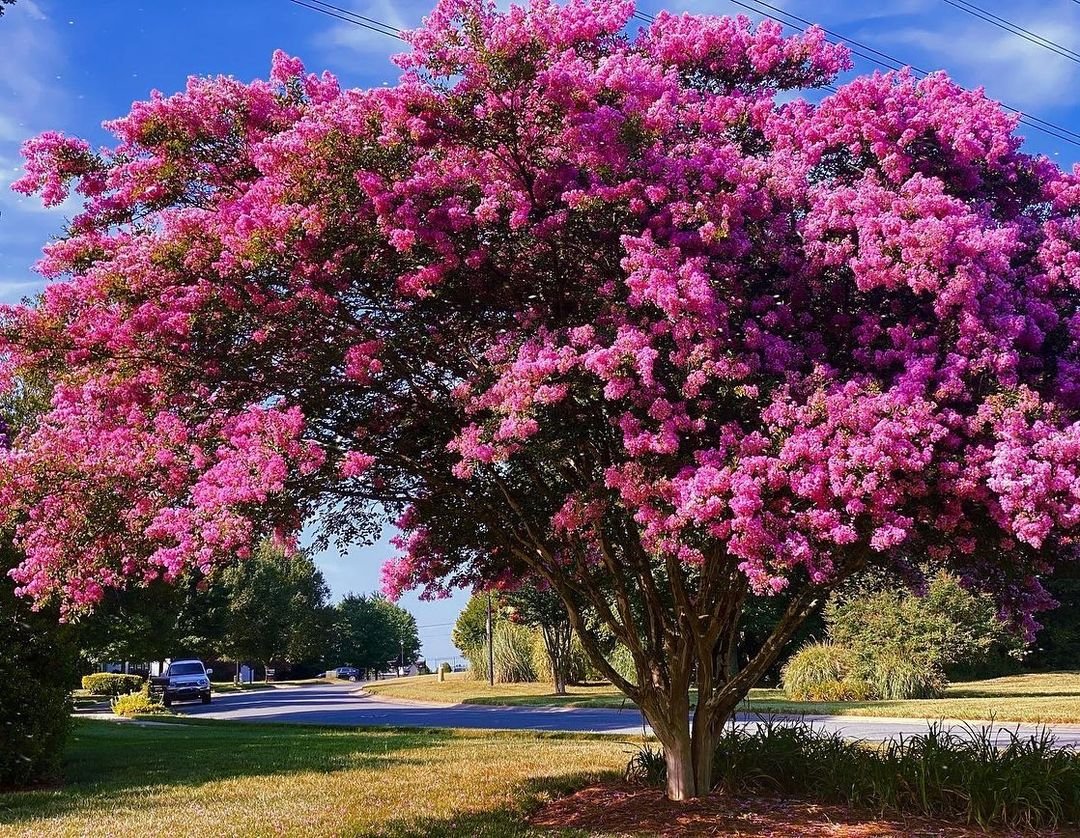
Here’s an easy and verified chart for Myrtle Trees (Myrtus communis):
| Category | Details |
|---|---|
| Botanical Name | Myrtus communis |
| Common Name | Myrtle Tree, Common Myrtle |
| Plant Name | Myrtle |
| Zone | Zones 8-11 |
| Sun Exposure | Full sun to partial shade |
| Soil Type | Well-draining, sandy or loamy soil |
| Watering | Regular; prefers moist but well-drained soil |
| Growth Habit | Evergreen shrub or small tree |
| Height/Spread | 6-15 feet tall, 6-15 feet wide |
| Special Features | Glossy, aromatic leaves; white or pink, fragrant flowers in summer; produces blue-black berries; used in traditional medicine and culinary applications; attractive to bees and other pollinators; used for hedges, topiary and ornamental purposes; culturally significant in Mediterranean regions |
Myrtle trees are evergreen shrubs or small trees native to the Mediterranean region. They’re known for their fragrant leaves and pretty white flowers.
Myrtle is special because:
- It has been used for thousands of years in medicine and perfumes
- Its leaves and berries can be used to flavor food
- It’s often used in gardens as a hedge or ornamental plant
In ancient times, myrtle was sacred to the goddess Venus. It was used in wedding ceremonies and was thought to bring good luck. Today, myrtle is still sometimes used in bridal bouquets, especially in royal weddings in Britain.
Myrtle oil, made from the leaves and flowers, is used in aromatherapy. It’s said to help with respiratory problems and skin conditions. However, always check with a doctor before using any new treatments.
Some fun facts about myrtle:
- The name comes from a Greek word meaning “perfume”
- In some places, myrtle is used to make a liqueur called Mirto
- Myrtle can live for a very long time – some trees are hundreds of years old
Discover more about myrtle and other Mediterranean plants from the Mediterranean Garden Society.
Mountain Ash Trees
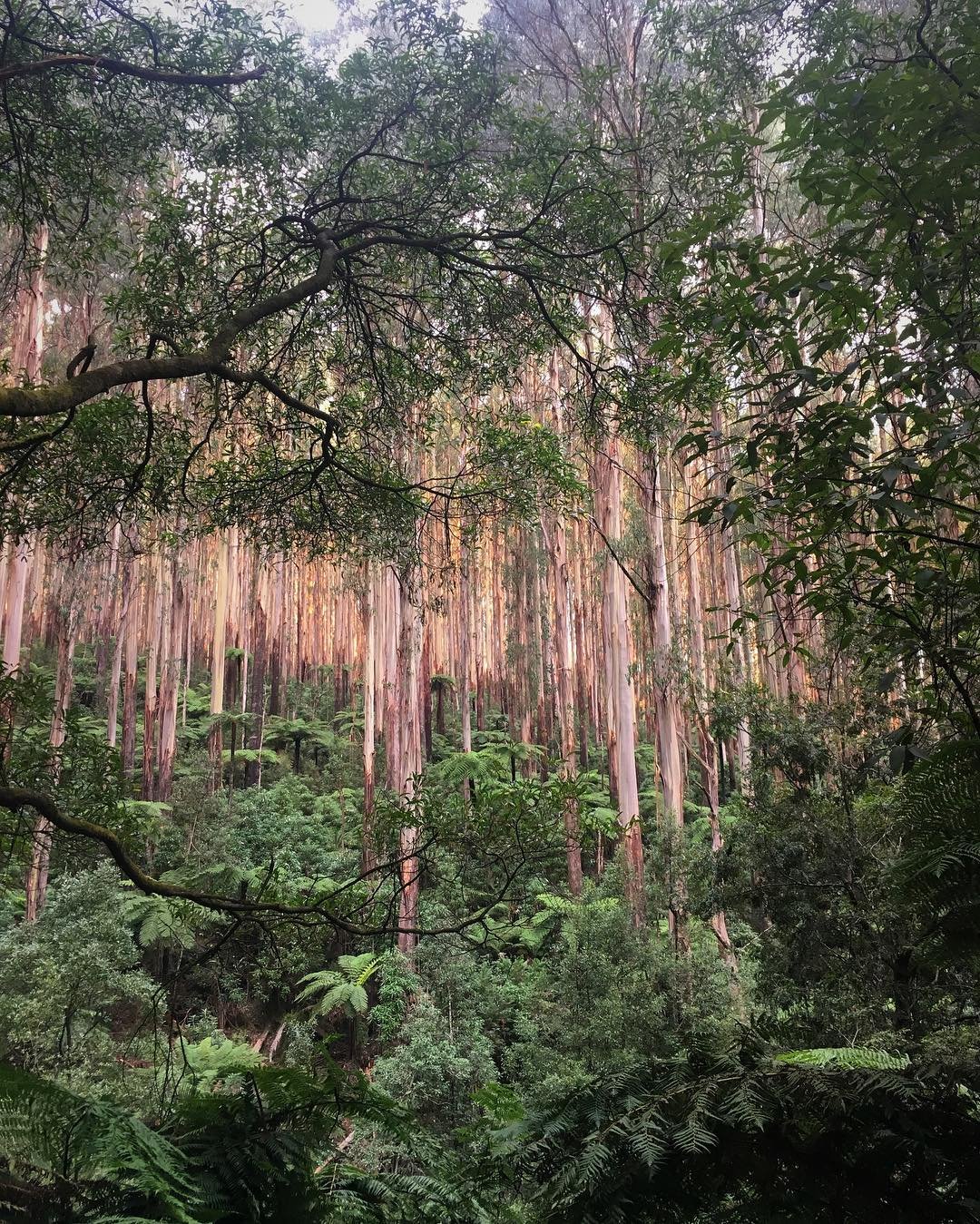
Here’s an easy and verified chart for Mountain Ash Trees (Sorbus spp.):
| Category | Details |
|---|---|
| Botanical Name | Sorbus spp. |
| Common Name | Mountain Ash, Rowan |
| Plant Name | Mountain Ash |
| Zone | Zones 3-6 (varies by species) |
| Sun Exposure | Full sun to partial shade |
| Soil Type | Well-draining, loamy or sandy soil |
| Watering | Regular; prefers consistently moist soil |
| Growth Habit | Deciduous tree |
| Height/Spread | 20-40 feet tall, 15-25 feet wide |
| Special Features | Compound leaves with serrated leaflets; white flowers in spring; bright red or orange berries in fall; attracts birds and wildlife; berries can be used to make jellies and wines; ornamental value for fall color and winter interest; relatively low maintenance; tolerant of cold climates |
Mountain Ash trees, also known as Rowan trees, are beautiful trees known for their bright red berries. Despite their name, they’re not related to true ash trees.
Mountain Ash trees are special because:
- They have pretty white flowers in spring and colorful berries in fall
- Their berries are food for many birds and animals
- They have a rich history in folklore and myths
In many parts of Europe, Mountain Ash trees were thought to have magical powers. People believed they could protect against evil spirits. Today, we know they have a different kind of power – they’re great for wildlife and add beauty to landscapes.
The berries of Mountain Ash trees are edible but very sour. They’re often made into jams or used to flavor spirits. Birds love these berries, especially in winter when other food is scarce.
Some interesting Mountain Ash facts:
- They can grow at high altitudes where other trees can’t survive
- Their wood is strong and was traditionally used to make tool handles
- In some languages, the tree is called “dog berry” because it was once used to treat rabies in dogs
Learn more about Mountain Ash trees from the Royal Horticultural Society.
Monkey Puzzle Trees
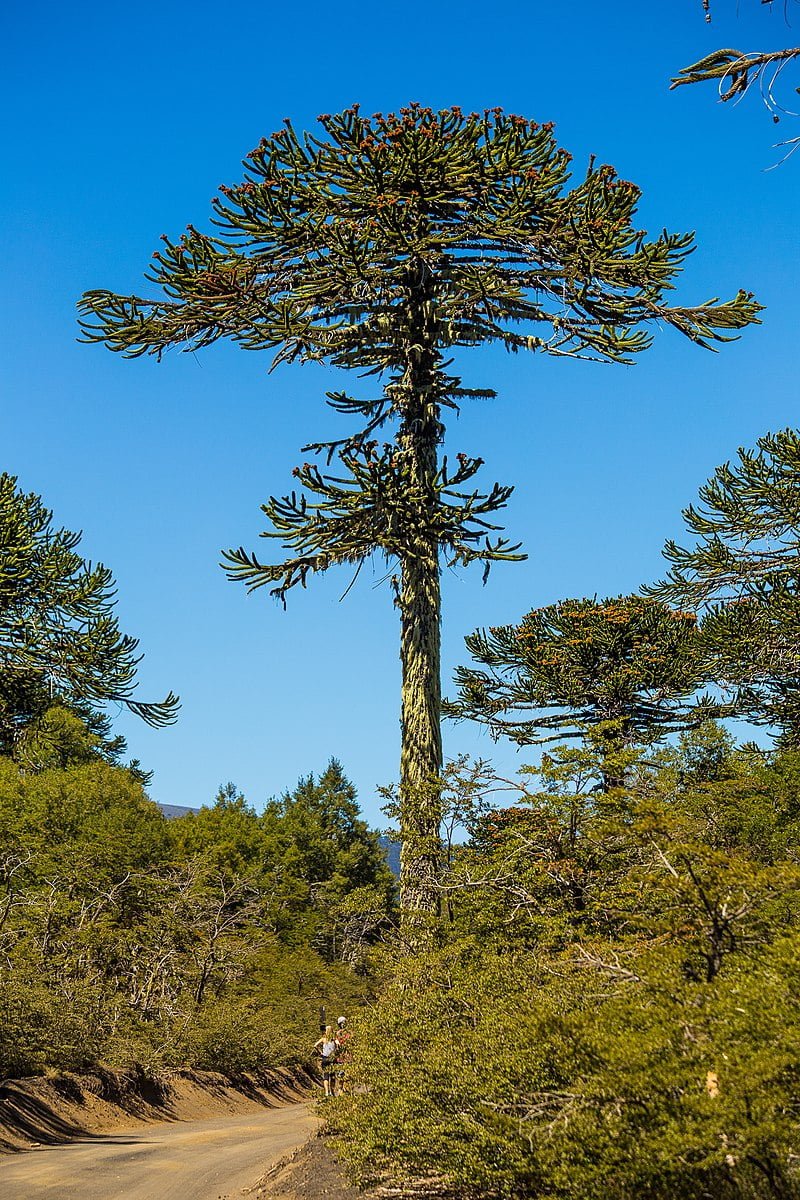
Here’s an easy and verified chart for Monkey Puzzle Trees (Araucaria araucana):
| Category | Details |
|---|---|
| Botanical Name | Araucaria araucana |
| Common Name | Monkey Puzzle Tree, Chilean Pine |
| Plant Name | Monkey Puzzle Tree |
| Zone | Zones 7-10 |
| Sun Exposure | Full sun |
| Soil Type | Well-draining, loamy or sandy soil |
| Watering | Regular; prefers consistently moist soil but can tolerate some drought once established |
| Growth Habit | Evergreen conifer tree |
| Height/Spread | 50-80 feet tall, 20-35 feet wide |
| Special Features | Unique, spiky, scale-like leaves; slow-growing; produces large, edible seeds; highly ornamental due to its unusual appearance; dioecious, with male and female cones on separate trees; native to Chile and Argentina; long-lived and can withstand cold temperatures and strong winds |
Monkey Puzzle trees are unusual evergreen trees native to Chile and Argentina. They got their strange name because someone once said that climbing the tree would puzzle even a monkey!
Monkey Puzzle trees are special because:
- They have a very unique look with spiky, scale-like leaves
- They can live for over 1,000 years
- They’re considered living fossils because they’ve been around since dinosaur times
These trees grow very slowly but can become very tall – up to 150 feet in their native habitat. They have thick, scaly bark that helps protect them from forest fires.
Monkey Puzzle trees are important in their native ecosystem. Their seeds, which are like large pine nuts, are food for animals and birds. In Chile, the seeds are also eaten by people.
Sadly, Monkey Puzzle trees are endangered in the wild due to logging and habitat loss. Many efforts are being made to protect these amazing trees.
Some fun Monkey Puzzle facts:
- The scientific name, Araucaria araucana, comes from the Arauco region of Chile
- Young trees are cone-shaped, but older trees have a flat top like an umbrella
- In Britain, they were popular ornamental trees in Victorian gardens
Find out more about Monkey Puzzle conservation from Rainforest Concern.
Trees that start with ‘M’ are a diverse and fascinating group. From the sweet sap of Maples to the ancient lineage of Magnolias, each tree has its own special features and importance.
These trees do more than just look pretty. They clean our air, provide homes for wildlife and in many cases, give us food and useful materials. Some, like Mangroves and Mahogany, are crucial for protecting our environment.
Next time you’re outside, take a moment to look at the trees around you. You might spot one of these ‘M’ trees! Remember, trees are a vital part of our world. By learning about them and protecting them, we’re helping to create a better future for everyone.
Whether you’re a nature lover, a gardener or just someone who enjoys learning new things, we hope this journey through the world of ‘M’ trees has been interesting and fun. There’s always more to learn about the amazing world of trees!
Pingback: Amazing Nature’s Trees that start with ‘P’